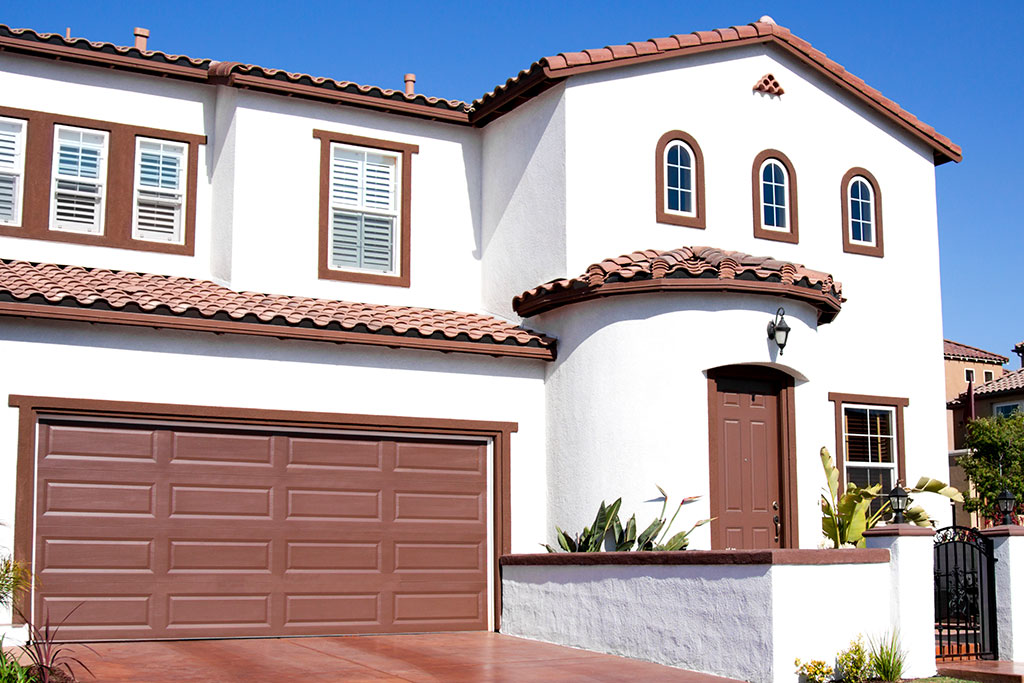Taking Care of Your Home’s Siding
You might remember to clean your countertops and floors on a regular basis, but what about the outside of your home? Your siding needs routine cleaning too. A sparkling exterior can help prevent structural damage and add to your property’s appeal.
From traditional brick or stone to modern options like vinyl and stucco, every kind of siding is susceptible to mold, mildew, and grime over time—especially in warm and wet climates. Before you pull out your power washer, read these tips for cleaning your siding safely and effectively.
*Be sure to wear rubber gloves and eye protection while working with bleach or other chemicals.

Vinyl
Vinyl siding is low-maintenance and only requires a gentle cleaning every two to three years. You can purchase a commercial vinyl cleaner, like Simple Green House and Siding Cleaner, but it’s not always necessary if you’re dealing with minimal dirt buildup.
Pressure-washer warning
If you decide to use your pressure washer, check with your vinyl manufacturer first to ensure pressure-washing is safe for your vinyl. A pressure washer’s strength is measured in pounds per square inch (PSI), so ask how much pressure your vinyl can handle.
Solution and technique
Create a solution of two parts warm water and one part dish soap or vinegar, and apply it to your siding using a soft-bristled brush. Rinse off the solution using medium pressure with a spray hose. For the best results, start at the bottom of your house and work your way up, rinsing top to bottom before the cleaning solution completely dries.

Brick or stone
Traditional brick and stone masonry can look charming, but both require more upkeep than vinyl. You should inspect and clean your exterior at least once a year. Before you start cleaning, inspect the masonry siding. If there are small cracks or missing mortar, you can repair it yourself with concrete caulk, or seek the help of a professional for large cracks.
General cleaning
For general cleaning of dirt and grime from your brick or stone siding, you should use a mild detergent, a hose, and a brush with a long handle. Do not use a power washer. You will risk damaging your mortar and caulking, especially if your masonry is painted; it will likely cause the paint to peel or fade.
Hard-water spots
Lawn sprinklers and heavy rain can leave dingy hard-water spots on your home’s exterior, but these can be carefully removed with an acid-based cleaner. Follow the label’s directions, cover nearby plants with a tarp, and apply the cleaner using a stiff-bristled nylon brush on an extension handle. Rinse the solution thoroughly with a garden hose when finished. Make sure everyone in your household avoids contact with nearby grass for forty-eight hours or the amount of time on the label’s safety guidelines.
Vegetation stains and algae
Vegetation and algae are often unavoidable on brick or stone siding, but you can remove them using an oxygen bleach solution. Get rid of any loose vegetation by scrubbing it away using gentle circular motions with a soft bristle brush. On a dry day, apply the oxygen bleach solution to the affected areas with a clean brush. Don’t rinse the solution in order to give it time to kill the roots of the vegetation—wait for the next rainfall to dilute it.

Stucco
Stucco is an eco-friendly and attractive siding option. However, due to its textured surface, it can accumulate large amounts of dirt, grime, mold, and algae. To keep your stucco looking like new, clean it two to three times a year.
Inspect
Like brick, you should inspect stucco for cracks, gaps, and openings before cleaning it. If you find hairline cracks and chips, use an acrylic caulk that matches the color of your stucco. For large cracks, hiring a professional is the best option to prevent water damage to your walls.
Rinse
Rinse the surface of your stucco to loosen dirt and other debris before applying any cleaning solution. You can use a soft-bristled brush or a pressure washer with a level of 1,500 PSI or below and a 25- or 40-degree nozzle. Leave at least twenty-four inches between the nozzle and the stucco surface, and rinse using a consistent stream at about a 45-degree angle.
Apply a mixture
Use a mixture of three parts liquid dish soap to two parts warm water to remove light stains. If there is mold, algae, or mildew, use equal parts bleach (or borax if you don’t like bleach) and hot water or a diluted commercial stucco cleaner.
Once you have your cleaning solution, apply it at a downward angle using a 65-degree nozzle tip (if your pressure washer can handle chemicals). Leave eighteen to twenty-four inches between the nozzle tip and the stucco surface. If you use a brush, apply the solution in circular motions with firm but gentle pressure. Let the solution sit for about five to ten minutes without letting it dry completely. You can keep it damp by lightly spraying it with water. Rinse thoroughly.

Wood
Clapboard, shingles, and board-and-batten siding have an elegant appearance, but they can be expensive siding options, so don’t let your investment go to waste. Rot is the biggest concern of homeowners with wood siding, so be sure to clean it once a year.
Pick the right cleaning solution
It’s important to choose a cleaning solution that is safe for your type of wood to avoid stripping it. Here are a few popular types of wood siding and what to use on them:
-
- Cedar: use oxygen bleach to preserve its oil-based stain
- Pine: make a solution of equal parts white vinegar and warm water
- Redwood: use a solution of warm water, mild soap, and diluted oxalic acid for tough stains
- Faux wood or any painted wood: use a solution of warm water, mild soap, and diluted vinegar on any mold or mildew
Scrubbing vs. pressure washing
When it comes to wood, people are divided on whether or not to use a pressure washer. It’s best to consult a home professional first or avoid pressure-washing if you can since it could strip your boards.
If you clean your wood siding manually, apply the cleaning solution using a soft-bristle brush. Rinse thoroughly soon after application so the solution doesn’t soak into the wood. Use a low-pressure setting between 1,000–1,500 PSI if you pressure-wash your wood. Stand about six feet away from your siding.
No matter what type of siding you have, a thorough cleaning can give your home a brand-new look!



